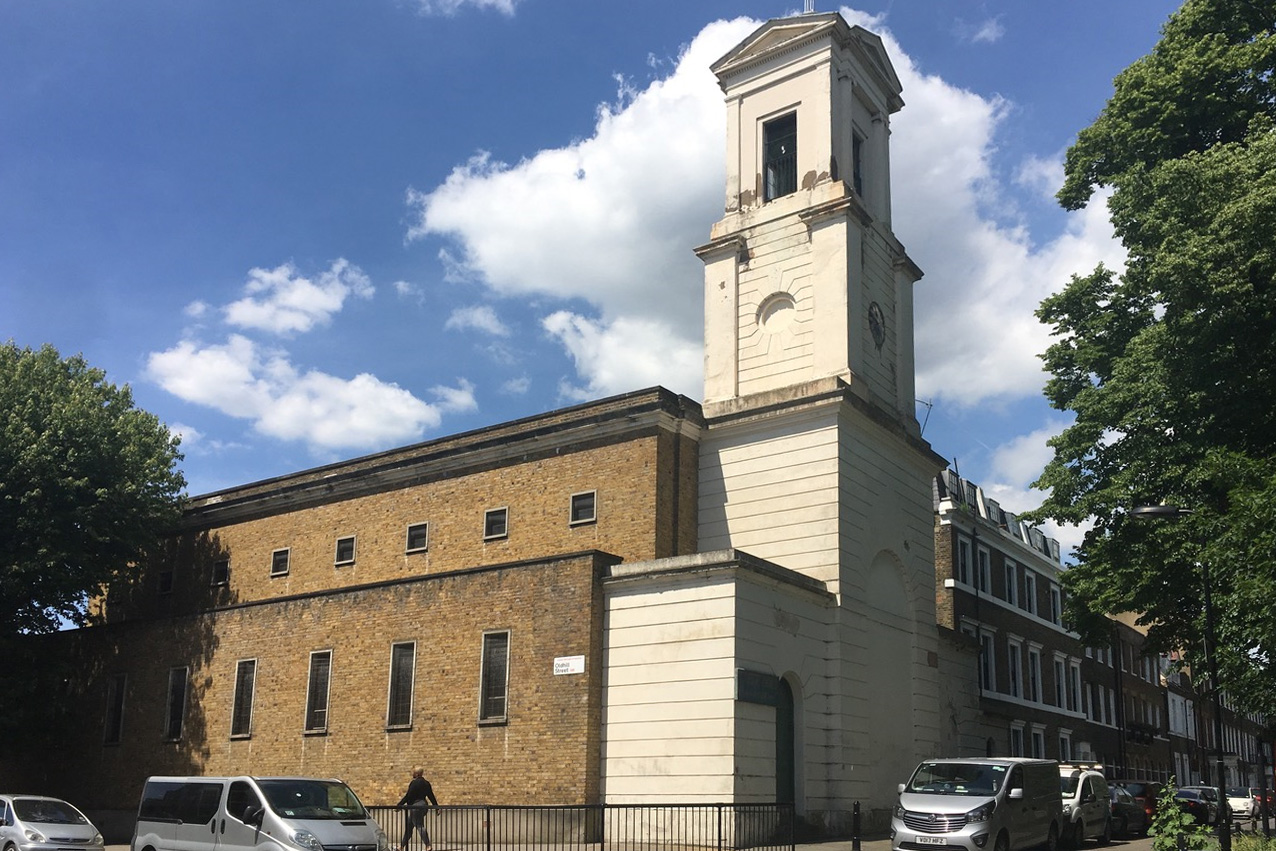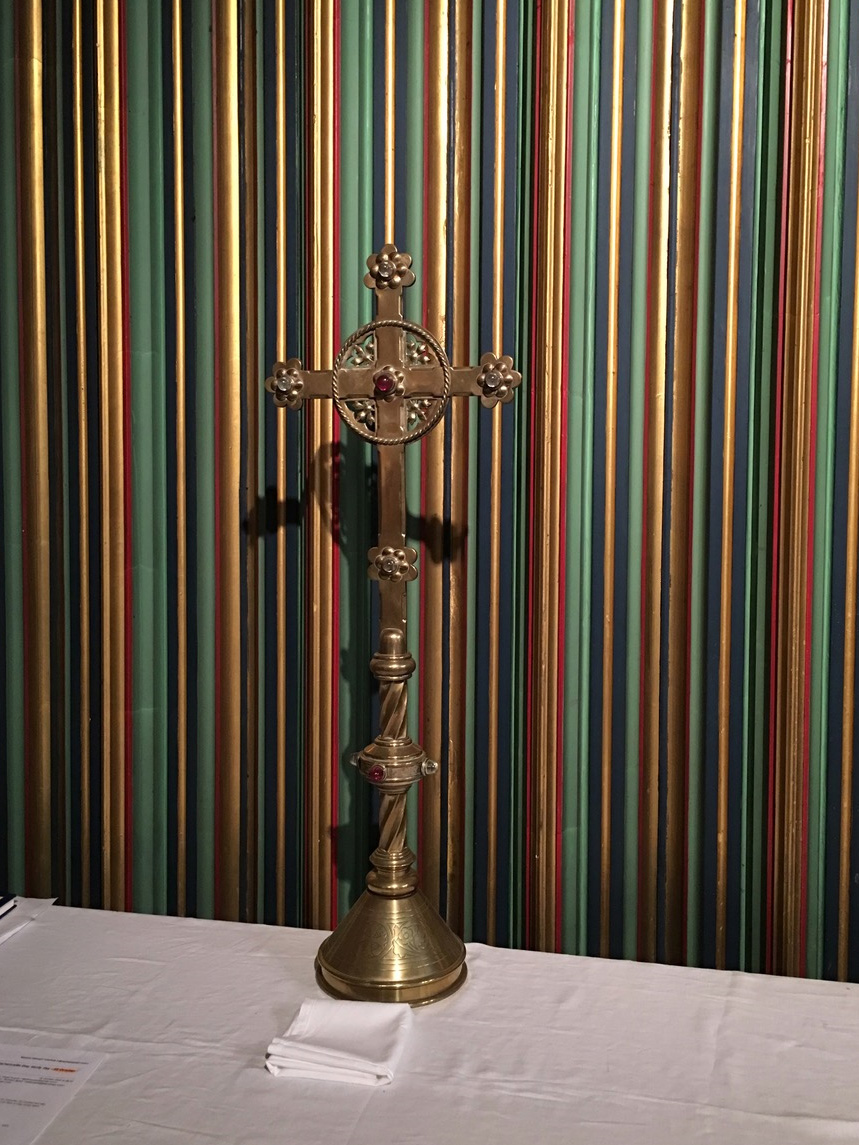| |
 |
 |
 |
| Comment on this report, or find other reports. |
 |
| Our Mystery Worshippers are volunteers who warm church pews for us around the world. If you'd like to become a Mystery Worshipper, start here. |
 |
| Find out how to reproduce this report in your church magazine or website. |
|
|
| 3311: St Thomas Clapton Common, Hackney, London |
 |
 |
 |
Mystery Worshipper: Cool Dude.
The church: St Thomas Clapton Common, Hackney, London.
Denomination: Church of England, Diocese of London.
The building: The original building dated from 1777 and was designed by architect Joseph Gwilt as a chapel of ease in the days when Hackney was still semi-rural. That building was destroyed by a WWII bomb, and what you see today is a rebuild dating from 1957 by the celebrated church architect Nugent Francis Cachemaille-Day. It is in the form of a Roman basilica, evoking the earliest years of the Church. The stuccoed clock tower fronting St Thomas was added in 1828 and survived the bombing; it is visible across Clapton Common and from the many buses that pass by, though as one approaches on foot it appears to be in need of repair and decoration. There is a handsome gilded apse behind the altar and a side chapel with a lovely multi-coloured reredos: vertical stripes that are actually calming, though you would expect them to be the opposite. The ceiling is dark with pollution and age. It looks as though it has not been decorated since 1957 and the large number of candles burning at this service suggest they may have helped to darken it!
The church: The congregation – to judge from turnout this Sunday – is majority Afro-Caribbean in origin. It was notably friendly and informal and there was evidence of parish projects such as a food bank and a group visit to Southend. The parish website has a rather nice strapline: "Citizens with the Saints."
The neighbourhood: The surrounding streets of Clapton and Stamford Hill are notable for housing the most visible and concentrated Jewish community in the UK. Mostly ultra-Orthodox – men dressed in traditional dark garb and amazing variety of large dark hats of Hasidic Jewish habit are to be seen hurrying everywhere in the streets on a Sunday. It is otherwise an unremarkable inner city area with pockets of considerable wealth but much poverty too, all jumbled together as is the way in many parts of inner London.
The cast: I deduced from the handsheet that the celebrant this week was the Revd Monica Stewart, assistant priest. There was an altar party of six.
The date & time: Sunday, 3 June 2018, 10.30am.
What was the name of the service?
Parish Eucharist.
How full was the building?
When I arrived in the nick of time for the start, there were ten people present and I assumed I was in for a lonely experience. By twenty minutes into the service this had almost trebled, which made the building comfortable. It could seat 120.
Did anyone welcome you personally?
A lady handed me a weekly handsheet, running order for the eucharist, and hymn book.
Was your pew comfortable?
A pew looking much older than the 1957 reconstruction of the church. I increasingly find old-fashioned pews more comfortable than modern chairs, many of which look inviting at first sight, but which turn out to be the wrong shape for me.
How would you describe the pre-service
atmosphere?
Quiet – at that stage there was a very sparse showing of souls.
What were the exact opening words of the
service?
"Will you start off the hymn please" – addressed by the priest to two ladies who looked slightly surprised at the request.
What books did the congregation use during the
service?
Handsheets and Complete Anglican Hymns Old and New.
What musical instruments were played?
A lone recorder accompanied half of the hymns, which were otherwise unaccompanied. We could have done with more help, especially to begin with when there were so few of us. There was a small pipe organ on the premises, but apparently nobody to play it.
Did anything distract you?
A distinctly uncertain start to the service, which got going five minutes late with only ten present and a processional hymn that we struggled to keep in tune and in time. There was incense but no crucifer to lead the procession.

Was the worship stiff-upper-lip, happy clappy, or
what?
Simple modern catholic. Plenty of incense, whose plumes the morning sun caught with artistic elegance.
Exactly how long was the sermon?
9 minutes.
On a scale of 1-10, how good was the preacher?
7 – The assistant priest spoke well, although microphone problems prevented me from hearing everything she said (see below). It did strike me as odd that she chose to illustrate the gospel reading, in which Jesus ignored the law, with references to the Orthodox Jewish community, who keep the letter of God's law as they see it with strict obedience. So, I was slightly unsure of the take-away points from this sermon.
In a nutshell, what was the sermon
about?
The texts for the day: invocations to keep the Sabbath from Deuteronomy 5:12-15, the slightly odd passage from 2 Corinthians 4:5-12 about treasure in clay jars, and a more helpful one from Mark's gospel (2:23-3:6) about Christ healing on the Sabbath, thereby breaking Jewish law. Her sermon embraced a disquisition about the need for Christians to be ever aware of anti-semitism, a message of power in this particular community where, she related, swastikas had been painted on walls recently.
Which part of the service was like being in
heaven?
The friendliness of the welcome and the morning sun catching the incense.
And which part was like being in... er... the other place?
The vicar had a tiny microphone on her vestments and there was also a mic in the pulpit/reading desk. But either it was off or the volume needed adjustment. It was difficult to hear much of the service, especially in the slightly odd acoustic of the 1950s church with its concrete ceiling.
What happened when you hung around after the service looking lost?
During the exchange of peace – a comprehensive affair that involved everyone in the room greeting everyone else – an elderly lady with a lilting Afro-Caribbean accent spotted me as a visitor and thanked me for joining them, asked my name and giving me hers. After the service several people spoke to me, gave me directions to the WC (the route, in spite of signs, is far from obvious), and offered me coffee. The priest chatted to me before I left. I overheard another newcomer saying he liked the friendly welcome he received. So, top marks for the welcome at St Thomas!
How would you describe the after-service
coffee?
On doctor's advice I have given up the bean, but it was being offered.
How would you feel about making this church your regular (where 10 = ecstatic, 0 = terminal)?
6 – If I lived nearer, I might. I am used to a slightly more formal service but St Thomas persuades with its warm welcome.
Did the service make you feel glad to be a
Christian?
Definitely.

What one thing will you remember about all this in seven days' time?
The friendly welcome. |
|
|
 |
 |
 |
| We rely on voluntary donations to stay online. If you're a regular visitor to Ship of Fools, please consider supporting us. |
 |
 |
 |
| The Mystery Pilgrim |
 |
| One of our most seasoned reporters makes the Camino pilgrimage to Santiago de Compostela in Spain. Read here. |
 |
 |
 |
| London churches |
 |
| Read reports from 70 London churches, visited by a small army of Mystery Worshippers on one single Sunday. Read here. |
| |
|
|
|
|


